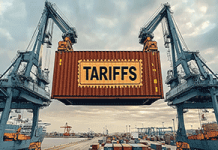 Starting August 29, imported goods sent through means other than the international postal network that are valued at or under $800 and that would otherwise qualify for the de minimis exemption will be subject to duties.
Starting August 29, imported goods sent through means other than the international postal network that are valued at or under $800 and that would otherwise qualify for the de minimis exemption will be subject to duties.
President Trump signed an executive order on July 31 that suspended duty-free de minimis treatment for low-value shipments. The White House described the executive order as closing a loophole used to evade tariffs and potentially funnel deadly synthetic opioids as well as other unsafe or below-market products.
Starting May 2, President Trump had ended duty-free de minimis treatment for low-value imports from the People’s Republic of China and Hong Kong.
International Postal System Methods
- For goods shipped through the international postal system, packages instead will be assessed duties according to one of the following methodologies:
– Ad valorem duty: A duty equal to the effective tariff rate imposed under the International Emergency Economic Powers Act (IEEPA) that is applicable to the country of origin of the product. This duty shall be assessed on the value of each package.
– Specific duty: A duty ranging from $80 per item to $200 per item, depending on the effective IEEPA tariff rate applicable to the country of origin of the product. The specific duty methodology will be available for six months, after which all applicable shipments must comply with the ad valorem duty methodology. - Longstanding exemptions remain in place, so U.S. travelers still can bring back up to $200 in personal items and individuals can continue to receive bona fide gifts valued at $100 or less duty-free.
- Packages entering the United States using the duty-free de minimis exemption typically are subject to less scrutiny than traditional imports; however, the packages can pose health, safety, national and economic security risks.
- Between 2015 and 2024, the volume of de minimis shipments entering the United States increased from 134 million shipments to more than 1.36 billion shipments. On average, U.S. Customs and Border Protection processes more than 4 million de minimis shipments into the U.S. each day.
Background
Congress established the de minimis policy in 1938 as Section 321 of the Tariff Act of 1930 allowed travelers returning to the United States to bring with them goods worth up to $5 without declaring them to customs. Since 2016, the threshold has been $800 and the de minimis rule has helped to reduce administrative burdens while it has grown to encompass more than 90% of all cargo entering the United States — 60% from China.
After Congress raised the qualifying threshold to shipments valued at less than $800 in 2016, the de minimis shipments increased — especially during the COVID years. China accounted for the majority of the shipments by far. In 2023, 62% of all de minimis shipments, valued at nearly $34 billion, came from China, according to U.S. Customs and Border Protection.
From 2018 to 2023, the amount of low-value e-commerce exports from China ballooned, according to the Congressional Research Service. The People’s Republic of China (PRC) expanded its global e-commerce exports more than tenfold.
A key part of China’s global e-commerce growth has been expanding PRC and PRC-tied e-commerce firms into the U.S. market. The U.S. retail e-commerce market makes up more than half of all global e-commerce sales. PRC e-commerce policies have promoted PRC exports while limiting the scope of PRC e-commerce imports.
Staff Contact: Susanne T. Stirling


